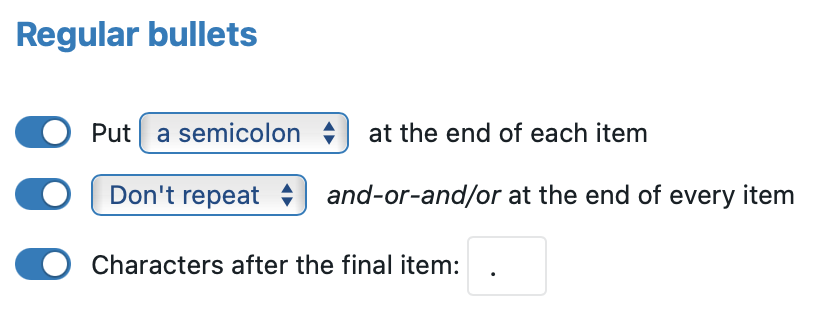The enumeration styling settings distinguishes between three different types of enumerations:
- regular bullets, i.e. bullets that are inserted by typing in one or more asterisks (*) in the body of a clause
- internal bullets, i.e. bullets that are inserted through one of the special codes for enumerations — such as
{ AND | ... }or{ LIST | ... }. Those internal bullets can finally result in:- items in the same block of text — also called “inline lists” in the documentation, for example (i) alpha, (ii) beta, (iii) gamma
- items on separate lines — i.e. real bulleted lists
Regular bullets
This section of the settings targets bullets that are inserted by typing in one or more asterisks (*) in the body of a clause, and inserting the right enumeration-type as the very first item.
For example, typing:
* alpha
* beta
* gamma
will result in three items, on separate lines, without any suffixes (such as semicolons / comma’s / etc.). If you want to insert such suffixes, you have to type:
* AND
* alpha
* beta
* gamma
Typing* AND, * OR, *AND/OR or *LIST will ensure that all items that follow, will be formatted with a suffix. What this suffix looks like, is determined by the enumeration styling discussed below.

The settings are fairly straightforward:
- The first setting allows you to specify the character that will be inserted at the end of each item (except for the very last item): a period, comma, semicolon or nothing.
- The second setting allows you to specify whether or not to repeat the “and”, “and/or” or “or” at the end of everyitem, or whether instead such suffix should only be inserted at the end of the penultimate item.
This second setting has no effect on enumerations created using the {LIST | ... } code or the @enumerate special function, because those will result in enumerations that do not show any such suffix.
- The third setting specifies the character (if any) that should be shown after the last item in the list. If you do not want any character at all, leave this blank.
Even when this setting is active, you can avoid that this character would be inserted in a specific enumeration, by using AND-SKIPFINAL, OR-SKIPFINAL, AND/OR-SKIPFINAL or LIST-SKIPFINAL (when explicitly typing in bullet-lists) or by using one of the special functions that have -skipfinal in their name (e.g., @enumerate-skipfinal).
Internal bullets

With this setting, you can configure when internal bullets — i.e. those inserted through one of the special codes for enumerations, such as { AND | ... } or { LIST | ... }— should be printed as text concatenations, and when they should be printed as real bulleted lists.
- always put each item on a separate line forces the internal bullets to always be shown as real bulleted lists
- concatenate items if possible will try to concatenate items, typically using romanettes — e.g. (i) … (ii) … (iii) …
As suggested by this option, there exist situations where concatenation is not possible. This will be the case when at least one of the items happens to consist of multiple paragraphs. In such case, it is obviously impossible to concatenate all items into one single paragraph. ClauseBase will therefore use real bulleted lists instead.
- concatenate items up to … words will use concatenated lists up to a maximum number of words. If the number of total words is higher, then real bulleted lists will be used instead.
Items in the same block of text (aka “Inline lists”)

These settings configure how concatenated lists of items should be shown:
- Put a comma/semicolon/space after each item.This setting specifies which character to insert after each item:
- a comma — alpha, beta, gamma
- a semicolon — alpha; beta; gamma
- a space — alpha beta gamma
- Repeat/don’t repeat and-or-and/or for every item.This setting specifies whether the “and”, “or” or “and/or” should be inserted:
- after each item — alpha, and beta, and gamma
- only after the penultimate item — alpha, beta and gamma
This setting has no effect on enumerations created using the {LIST | ... } code or the @enumerate special function, because those will result in enumerations that do not show any such suffix.
- Show/don’t show the comma when and-or-and/or is shown.This setting specifies whether the comma/semicolon/space should be shown when an “and”, “or” or “and/or” is shown:
- do show — alpha, beta, and gamma
- don’t show — alpha, beta and gamma
- Only number items when suggested by the clause author. This setting allows you to force an enumeration to always show numbers as prefixed for each item. In principle, such numbers are only shown when you explicitly type in numbers when coding enumerations — e.g. by using
{ AND | 1. alpha | 2. beta}instead of{ AND | alpha | beta}, or by using@enumerate-numbered(...)instead of@enumerate(...). When this setting is enabled, inline enumerations will always show their number. - Level customizations. This setting allows you to specify how the number of each level should be formatted. Instead of using the default romanette surrounded by round parentheses (i), you can for example choose square brackets around arabic numbers [1].
Items on separate lines

The settings you see here, are identical to those of the Regular Bullets section described above. However, these settings only apply to internal bullets and happen to get formatted as real bulleted lists.